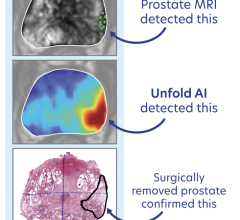
June 22, 2015 - Augmenix Inc. announced the publication of the 222-patient pivotal study designed to evaluate safety and efficacy of the SpaceOAR System in men undergoing prostate radiotherapy. By creating space between the prostate and rectum, the SpaceOAR System is intended to reduce the radiation dose delivered to the rectum during prostate radiotherapy. The favorable results from the multi-center, randomized, single-blind study led to the April 1, 2015, U.S. Food and Drug Administration (FDA) clearance of the SpaceOAR System.
Electronically published in International Journal of Radiation Oncology"¢Biology"¢Physics (Red Journal), the official journal of the American Society for Therapeutic Radiology and Oncology (ASTRO), the study demonstrated product safety and effectiveness. Spacer application was well tolerated by patients, and on average increased prostate-rectum space from 1.6mm to 12.6mm. This extra space reduced the average rectal V70 radiation dose (percent of rectum volume receiving 70 Gray radiation) from 12.4 percent to 3.3 percent, a 73 percent relative decline compared to the control group (no spacer). This decreased radiation led to additional key patient benefits compared to the control group, including:
- Reduced reports of rectal pain during radiation treatment by 76 percent;
- Reduction in rectal toxicity by 71 percent in the year following radiotherapy;
- Reduction in percent of patients experiencing significant declines in bowel quality of life by 46 percent, as measured one year following radiotherapy.
"In the field of prostate radiotherapy, the rectum dose reduction seen in this trial is unprecedented," said Richard Hudes, M.D., of Chesapeake Urology and a study investigator. "This new ability to safely reduce rectum radiation may enable advanced protocols, like prostate stereotactic body radiation therapy, resulting in significant cost savings, as well as in prostate dose escalation, potentially decreasing cancer recurrence."
Historically, because the prostate lies next to the rectal wall, the rectum has been defined as the organ at risk (OAR) in men undergoing prostate radiation treatment. This close proximity means that small errors in patient positioning or movement during radiation delivery can lead to inadvertent rectal radiation, potentially resulting in long-lasting rectal toxicity (complications) like diarrhea, bleeding and pain.
The SpaceOAR System was developed to minimize the risk of rectal damage during prostate radiotherapy. It is a soft, gel-like material that temporarily moves the rectum away from the prostate during a course of radiotherapy, thus reducing the likelihood of rectum radiation injury.
"Spacer application in the study was well tolerated, the gel lasted through radiation treatment and was shown to completely absorb, leaving nothing behind," said Lawrence Karsh, M.D., a study investigator from The Urology Center of Colorado in Denver. "From the urologist perspective, a product that reduces the complications in patients selecting prostate radiotherapy is a tremendous advance that should be considered when patients are weighing treatment options."
The SpaceOAR System is also CE marked and TGA approved.
For more information: www.augmenix.com


 April 17, 2024
April 17, 2024 








